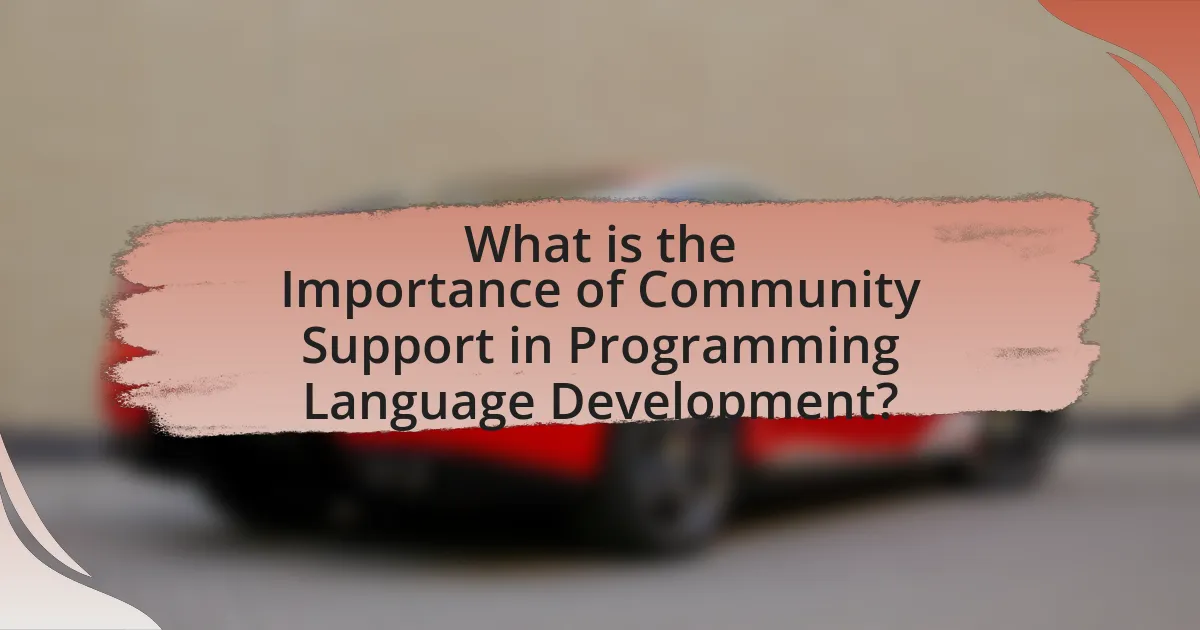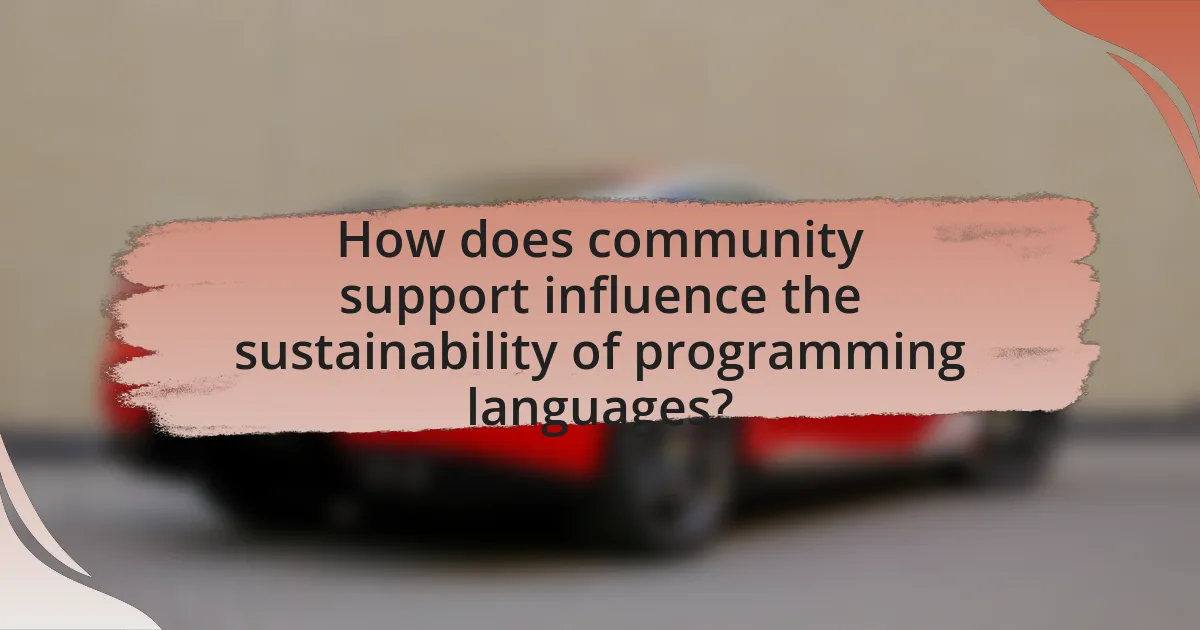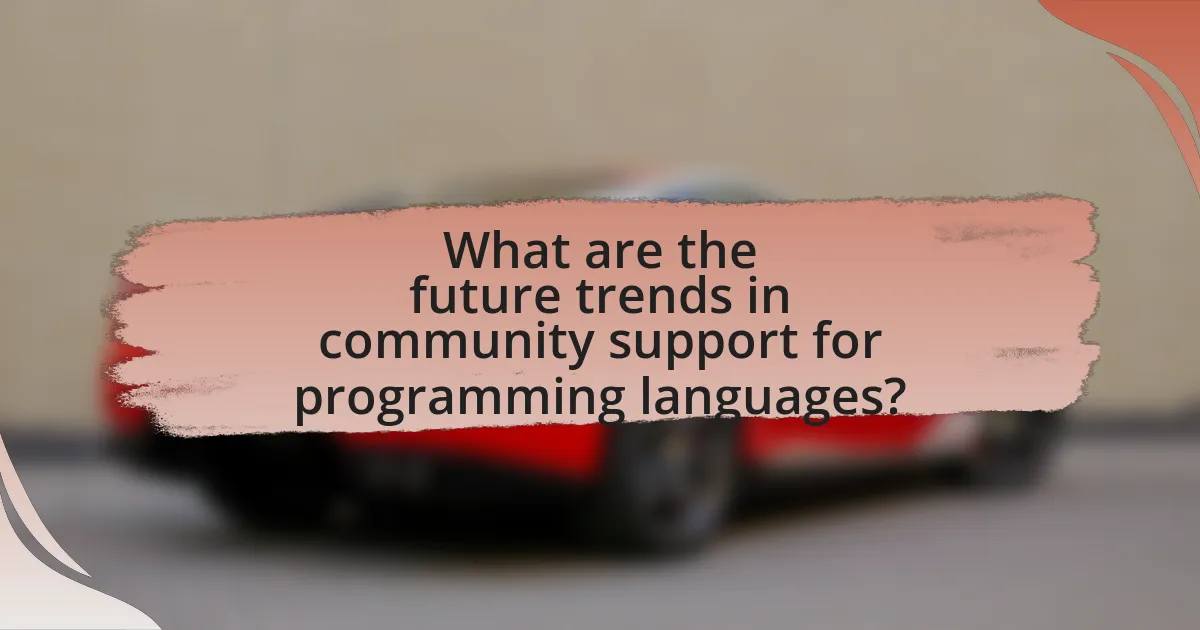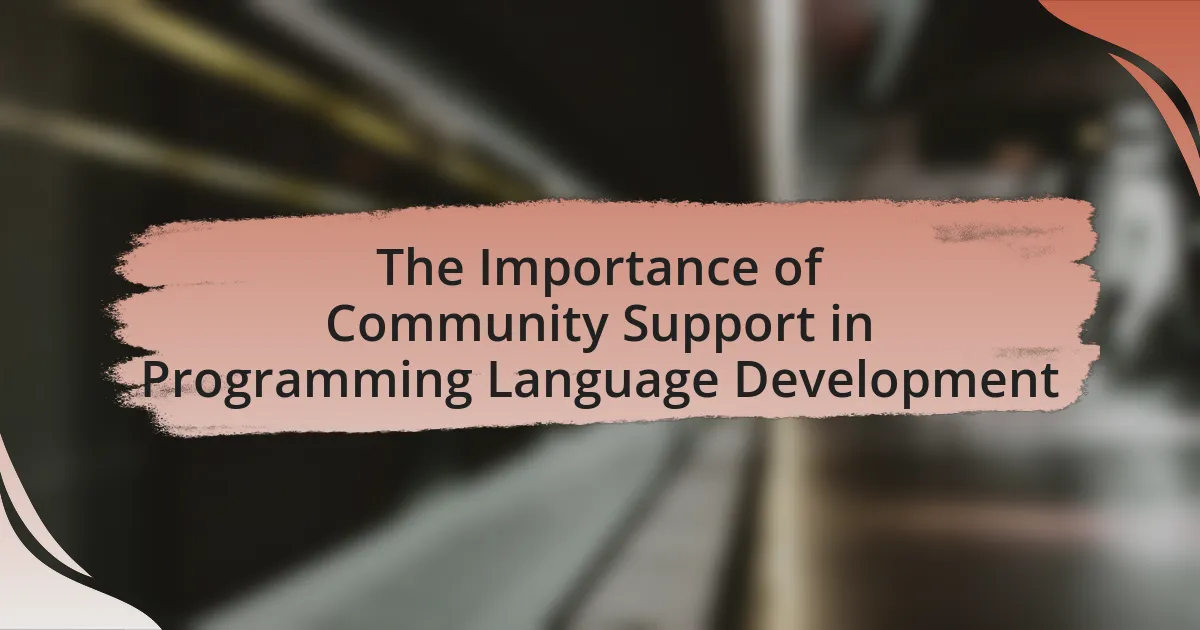Community support plays a vital role in the development of programming languages by fostering collaboration, enhancing problem-solving, and driving innovation. A strong community contributes to documentation, libraries, and frameworks, significantly influencing the growth and functionality of languages like Python and JavaScript. Community feedback is essential for identifying user needs and guiding language evolution, while active participation leads to increased adoption rates and sustainability. Mechanisms such as open-source licensing and collaborative platforms facilitate contributions, although challenges like resource limitations and engagement maintenance persist. Future trends indicate a shift towards more inclusive and accessible community support structures, driven by emerging technologies and enhanced online platforms.

What is the Importance of Community Support in Programming Language Development?
Community support is crucial in programming language development as it fosters collaboration, enhances problem-solving, and drives innovation. A strong community provides valuable feedback, contributes to documentation, and creates libraries and frameworks that extend the language’s capabilities. For instance, the Python community has significantly influenced its growth through contributions to libraries like NumPy and Pandas, which are essential for data analysis. Additionally, community-driven platforms like GitHub facilitate open-source collaboration, allowing developers to share code and improve language features collectively. This collaborative environment accelerates the evolution of programming languages, ensuring they remain relevant and effective in addressing modern challenges.
Why is community support crucial for programming languages?
Community support is crucial for programming languages because it fosters collaboration, enhances learning, and drives innovation. A strong community provides resources such as documentation, tutorials, and forums, which facilitate knowledge sharing and problem-solving among users. For instance, languages like Python and JavaScript have thriving communities that contribute to extensive libraries and frameworks, significantly accelerating development processes. Furthermore, community feedback helps language maintainers identify bugs and prioritize features, ensuring the language evolves to meet user needs effectively. This collaborative environment not only improves the language’s functionality but also increases its adoption and longevity in the tech ecosystem.
What role does community feedback play in language evolution?
Community feedback is crucial in language evolution as it directly influences the development and adaptation of programming languages. Feedback from users helps identify pain points, desired features, and usability issues, which in turn guides language designers in making informed decisions. For instance, the evolution of Python was significantly shaped by community input through forums and enhancement proposals, leading to the introduction of features that enhance functionality and user experience. This iterative process ensures that programming languages remain relevant and effective in meeting the needs of their users, demonstrating the vital role of community engagement in shaping language development.
How does community involvement enhance language features?
Community involvement enhances language features by facilitating collaborative development and feedback, which leads to more robust and user-friendly programming languages. When a diverse group of users contributes to a language’s evolution, they provide insights into practical use cases and potential improvements. For instance, the Python programming language has thrived due to its active community, which regularly contributes libraries, frameworks, and documentation, thereby enriching its feature set and usability. This collaborative approach not only accelerates innovation but also ensures that the language evolves in alignment with the needs of its users, as evidenced by the numerous enhancements made through community-driven proposals and discussions.
What are the key benefits of community support in programming language development?
Community support in programming language development provides several key benefits, including enhanced collaboration, rapid problem-solving, and increased innovation. Enhanced collaboration occurs as developers share knowledge, resources, and best practices, leading to a more robust development process. Rapid problem-solving is facilitated by the collective expertise of community members, allowing for quicker identification and resolution of issues, as evidenced by platforms like Stack Overflow where developers frequently assist each other. Increased innovation arises from diverse perspectives within the community, which can lead to new features and improvements, as seen in languages like Python, where community contributions have significantly shaped its evolution.
How does community support foster innovation in programming languages?
Community support fosters innovation in programming languages by facilitating collaboration, knowledge sharing, and rapid feedback among developers. This collaborative environment encourages the exploration of new ideas and techniques, leading to the development of innovative features and improvements. For instance, open-source programming languages like Python and Ruby have thrived due to active community contributions, which have resulted in a wealth of libraries and frameworks that enhance functionality and usability. Additionally, community-driven events such as hackathons and meetups provide platforms for developers to showcase their work, receive constructive criticism, and iterate on their projects, further driving innovation.
What impact does community support have on language adoption rates?
Community support significantly enhances language adoption rates by fostering a collaborative environment that encourages learning and usage. When a programming language has an active community, it provides resources such as tutorials, forums, and libraries, which facilitate easier onboarding for new users. For instance, languages like Python and JavaScript have seen rapid adoption partly due to their strong communities that offer extensive documentation and support networks. Research indicates that languages with vibrant communities experience higher growth rates; for example, the TIOBE Index shows that Python’s popularity surged as community contributions increased, highlighting the direct correlation between community engagement and language adoption.

How does community support influence the sustainability of programming languages?
Community support significantly enhances the sustainability of programming languages by fostering collaboration, knowledge sharing, and continuous improvement. A strong community contributes to the longevity of a programming language through active participation in forums, development of libraries, and creation of educational resources. For instance, languages like Python and JavaScript have thriving communities that regularly update documentation, create frameworks, and provide support, which in turn attracts new users and developers. This cycle of engagement ensures that the language evolves to meet modern needs, as evidenced by the consistent updates and enhancements seen in these languages over the years. Furthermore, studies have shown that programming languages with robust community backing tend to have higher adoption rates and longer lifespans, as community-driven initiatives often lead to innovative features and better performance.
What mechanisms facilitate community contributions to programming languages?
Community contributions to programming languages are facilitated by mechanisms such as open-source licensing, collaborative platforms, and community-driven governance. Open-source licensing allows developers to freely use, modify, and distribute code, encouraging participation. Collaborative platforms like GitHub provide tools for version control, issue tracking, and code review, making it easier for contributors to collaborate on projects. Community-driven governance structures, such as steering committees or contribution guidelines, help manage contributions and ensure that community input is valued and integrated into the language’s development. These mechanisms collectively enhance engagement and innovation within programming language communities.
How do open-source projects benefit from community involvement?
Open-source projects benefit from community involvement by gaining diverse contributions that enhance the project’s quality and functionality. Community members provide code improvements, bug fixes, and feature suggestions, which collectively lead to a more robust and innovative software product. For instance, the Linux operating system has thrived due to contributions from thousands of developers worldwide, resulting in a highly stable and secure platform. Additionally, community involvement fosters a sense of ownership and collaboration, encouraging more users to engage with and support the project, as seen in successful projects like Mozilla Firefox, which relies heavily on community feedback for its development.
What are the challenges faced by communities in supporting programming languages?
Communities face several challenges in supporting programming languages, including resource limitations, fragmentation of efforts, and maintaining engagement. Resource limitations often hinder communities from providing adequate documentation, tutorials, and support channels, which are essential for user adoption and language growth. Fragmentation occurs when multiple groups work on similar projects without collaboration, leading to duplicated efforts and inconsistent resources. Maintaining engagement is also difficult, as community members may lose interest over time, resulting in a decline in contributions and support. These challenges can significantly impact the sustainability and evolution of programming languages within their respective communities.
How can communities effectively support programming language development?
Communities can effectively support programming language development by fostering collaboration, sharing resources, and providing feedback. Collaborative efforts, such as open-source contributions, allow developers to enhance the language’s features and fix bugs collectively. For instance, the Python community has thrived due to its active participation in open-source projects, leading to significant improvements and widespread adoption. Additionally, communities can create and maintain documentation, tutorials, and forums, which facilitate knowledge sharing and help newcomers learn the language more efficiently. The success of languages like Ruby and JavaScript can be attributed to their supportive communities that offer extensive resources and mentorship. Furthermore, regular meetups and conferences enable developers to exchange ideas and showcase advancements, reinforcing community engagement and innovation.
What strategies can be implemented to encourage community engagement?
To encourage community engagement, organizations can implement strategies such as hosting regular events, creating online forums, and providing incentives for participation. Hosting events, such as workshops or meetups, fosters face-to-face interactions, which can enhance relationships and collaboration among community members. Online forums, like discussion boards or social media groups, allow for continuous dialogue and sharing of ideas, making it easier for individuals to connect regardless of location. Additionally, offering incentives, such as recognition programs or rewards for contributions, can motivate individuals to engage more actively. Research indicates that communities with active participation see a 30% increase in project success rates, highlighting the effectiveness of these strategies in fostering engagement.
How can communities ensure diverse participation in language development?
Communities can ensure diverse participation in language development by actively engaging various demographic groups through inclusive outreach and collaboration. This can be achieved by organizing workshops, hackathons, and forums that specifically target underrepresented communities, thereby fostering an environment where diverse voices contribute to the development process. Research indicates that diverse teams lead to more innovative solutions; for instance, a study by McKinsey & Company found that companies with diverse workforces are 35% more likely to outperform their peers in terms of financial returns. By implementing strategies that prioritize inclusivity, communities can enhance participation and ultimately improve the quality and relevance of language development initiatives.

What are the future trends in community support for programming languages?
Future trends in community support for programming languages include increased collaboration through open-source contributions, enhanced online learning platforms, and the rise of specialized communities focused on niche languages. Open-source projects are projected to grow, as platforms like GitHub facilitate easier collaboration, allowing developers to contribute to language development and share resources. Online learning platforms, such as Codecademy and Coursera, are expanding their offerings, providing structured learning paths that foster community engagement and support. Additionally, the emergence of specialized forums and social media groups dedicated to specific programming languages is expected to enhance peer support and knowledge sharing, creating more robust ecosystems around these languages. These trends indicate a shift towards more inclusive and accessible community support structures, which are essential for the ongoing evolution of programming languages.
How is technology shaping community support in programming language development?
Technology is shaping community support in programming language development by facilitating collaboration and knowledge sharing among developers. Online platforms such as GitHub and Stack Overflow enable programmers to contribute to projects, ask questions, and share solutions, thereby enhancing collective problem-solving capabilities. For instance, GitHub hosts millions of repositories where developers can collaborate on open-source projects, leading to rapid advancements in programming languages. Additionally, forums and social media allow for real-time communication and feedback, fostering a sense of community and encouraging mentorship. This interconnectedness not only accelerates language evolution but also ensures that diverse perspectives are integrated into development processes, ultimately leading to more robust and user-friendly programming languages.
What role do social media and online platforms play in community engagement?
Social media and online platforms serve as vital tools for community engagement by facilitating communication, collaboration, and information sharing among members. These platforms enable users to connect with like-minded individuals, share resources, and participate in discussions, thereby fostering a sense of belonging and community. For instance, studies show that 70% of community members feel more connected through social media interactions, which enhances their involvement in community initiatives. Additionally, platforms like GitHub and Stack Overflow allow developers to collaborate on projects, share knowledge, and provide support, directly contributing to the growth and improvement of programming languages.
How can emerging technologies enhance community collaboration?
Emerging technologies enhance community collaboration by providing platforms and tools that facilitate communication, resource sharing, and collective problem-solving. For instance, collaborative software like GitHub allows developers to work together on programming projects in real-time, enabling version control and issue tracking, which streamlines the development process. Additionally, social media and messaging apps foster community engagement by allowing members to share knowledge, seek assistance, and organize events, thus strengthening community ties. Research indicates that communities utilizing these technologies experience increased participation and innovation, as evidenced by the rise of open-source projects that thrive on collaborative contributions from diverse individuals.
What best practices can communities adopt to strengthen their support for programming languages?
Communities can strengthen their support for programming languages by fostering collaboration, providing educational resources, and encouraging contributions to open-source projects. Collaboration among community members enhances knowledge sharing and problem-solving, which is essential for language development. Educational resources, such as tutorials, workshops, and documentation, empower users to learn and effectively utilize the programming language. Encouraging contributions to open-source projects not only improves the language but also builds a sense of ownership and investment among community members. These practices have been shown to increase engagement and innovation, as evidenced by successful programming languages like Python and JavaScript, which thrive on active community involvement and support.
How can communities create effective communication channels?
Communities can create effective communication channels by utilizing a combination of digital platforms, regular meetings, and feedback mechanisms. Digital platforms such as forums, social media, and messaging apps facilitate real-time communication and information sharing among community members. Regular meetings, whether virtual or in-person, foster relationship building and collaborative problem-solving. Feedback mechanisms, such as surveys or suggestion boxes, ensure that all voices are heard and that the communication channels remain relevant and effective. Research indicates that communities with structured communication strategies experience higher engagement and satisfaction, which is crucial for the development and support of programming languages.
What are the key elements of a successful community-driven project?
The key elements of a successful community-driven project include active community engagement, clear communication, shared goals, and effective leadership. Active community engagement ensures that members feel valued and motivated to contribute, which is crucial for project sustainability. Clear communication facilitates collaboration and helps in addressing issues promptly, fostering a transparent environment. Shared goals align the community’s efforts and provide a common purpose, enhancing collective motivation. Effective leadership guides the project, making strategic decisions and nurturing community dynamics. Research indicates that projects with these elements, such as the development of the Python programming language, have shown significant growth and user adoption, highlighting the importance of community support in programming language development.

Leave a Reply